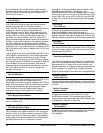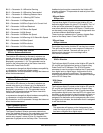
104 www.emersonct.com SM-EZMotion Module User Guide
(pins 2, 3, and 4) are configured as Inputs or Outputs using
PowerTools Pro EZ software. The SlotX.IO.#.Direction
parameter is used to configure whether the I/O point acts
as a digital input or digital output. Valid entries for this
parameter are selInput or selOutput. This parameter is
modified automatically when the user changes the settings
on the Slot X view.
SlotX IO Status
SlotX.IO.#.In
This parameter is only available when an SM-I/O Plus
module has been populated in one of the Unidrive SP slots.
The X in “SlotX” defines the slot number that the SM-I/O
Plus module has been fitted in. For example, if the I/O Plus
module is in slot 2, the parameter would be named
Slot2.IO.#.In.
The first three digital I/O points on the SM-I/O Plus module
(pins 2, 3, and 4) are configured as Inputs or Outputs using
PowerTools Pro EZ software. The “.In” at the end of the
parameter name is optional, therefore this parameter is
often referred to as simply SlotX.IO.#. If the I/O point has
been configured as a digital input, then the SlotX.IO.#.In
signal can be used in a user program to check the status of
inputs, or on the Assignments view to activate different
signals.
Note
This parameter will appear on the Assignments view
under the Inputs group of Sources even if the I/O point
has been configured as a digital output.
SlotX IO Name
SlotX.IO.#.Name
This parameter is only available when an SM-I/O Plus
module has been populated in one of the Unidrive SP slots.
The X in “SlotX” defines the slot number that the SM-I/O
Plus module has been fitted in. For example, if the I/O Plus
module is in slot 2, the parameter would be named
Slot2.IO.#.Name.
Each digital I/O point on the SM-I/O Plus module can be
given a name. The name can be used in a user program to
reference a specific I/O point. The name can be up to 12
alphanumeric characters, but must begin with a
non-numeric character.
Slot X IO State
SlotX.IO.#.Out
This parameter is only available when an SM-I/O Plus
module has been populated in one of the Unidrive SP slots.
The X in “SlotX” defines the slot number that the SM-I/O
Plus module has been fitted in. For example, if the I/O Plus
module is in slot 2, the parameter would be named
Slot2.IO.#.Out.
The first three digital I/O points on the SM-I/O Plus module
(pins 2, 3, and 4) are configured as Inputs or Outputs using
PowerTools Pro EZ software. The “.Out” at the end of the
parameter name is optional, therefore this parameter is
often referred to as simply SlotX.IO.#. If the I/O points have
been configured as digital outputs, then the SlotX.IO.#.Out
signal can be used in a user program to activate an output,
or on the Assignments view to activate when a specified
Source event activates. If assigned to a source on the
assignments view, when the source event activates, the
output that it is assigned to will turn on.
Note
This parameter will appear on the Assignments view
under the Outputs group of Destinations even if the I/O
point has been configured as a digital input.
SlotX Relay Name
SlotX.Relay.#.Name
This parameter is only available when an SM-I/O Plus
module has been populated in one of the Unidrive SP slots.
The X in “SlotX” defines the slot number that the SM-I/O
Plus module has been fitted in. For example, if the I/O Plus
module is in slot 2, the parameter would be named
Slot2.Relay.#.Name.
Each relay output on the SM-I/O Plus module can be given
a name. The name can be used in a user program to
reference a specific relay output if desired. The name can
be up to 12 alphanumeric characters, but must begin with
a non-numeric character.
SlotX Relay State
SlotX.Relay.#.Out
This parameter is only available when an SM-I/O Plus
module has been populated in one of the Unidrive SP slots.
The X in “SlotX” defines the slot number that the SM-I/O
Plus module has been fitted in. For example, if the I/O Plus
module is in slot 2, the parameter would be named
Slot2.Relay.#.Out.
The SM-I/O Plus module has two relay outputs (pins 21
and 23) that can be used to control devices that require
more current than a standard digital output. The “.Out” at
the end of the parameter name is optional, so this
parameter is often referred to simply as SlotX.Relay.#. This
parameter can be used in a user program to activate the
output (i.e. Slot2.Relay.8 = On), or can be assigned to a
Source on the Assignment view.
Enable Software Travel Limits
SoftwareTravelLimitEnable
Software travel limits can be used to limit machine travel.
They are often setup inside the hardware travel limits to


















